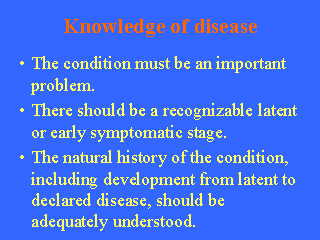|
|
|
|
front |1 |2 |3 |4 |5 |6 |7 |8 |9 |10 |11 |12 |13 |14 |15 |16 |17 |18 |19 |20 |21 |22 |23 |24 |25 |review |
 |
When offering a screening test to an entire population the burden
of the disease must be considered. While the prevalence of disease
is important, it must be balanced with the severity of the disease
and other considerations. Therefore, a rare disease such as
Phenylketonuria, is worth screening for because its consequences
are severe, and early treatment is beneficial. Advances in knowledge do change the second criterion somewhat. Genetic susceptibility testing was unheard of at the time Wilson and Jungner wrote their report. However, this point highlights the important consideration that there must be some phase prior to disease onset that screening highlights. The third point is critical, particularly when considering genetic susceptibility tests. What happens to individuals with screen detected disease must be understood. Our lack of understanding to what happens to individuals who have cancer genetic mutations leads to controversies about the use of these tests. |